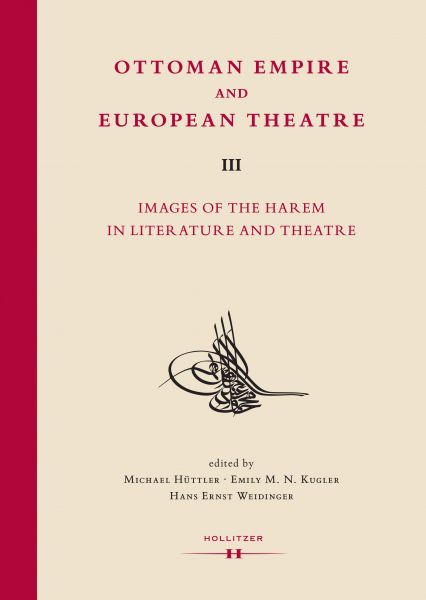Ottoman Empire and European Theatre Vol. III
Images of the Harem in Literature and Theatre.
On 3 May 1810 George Gordon, Lord Byron, swam like the mythic Leander from Sestos on the European side of the Hellespont to Abydos on the Asian shore. The hero of his poem "Don Juan" has lived in “feminine disguise” in the sultan's harem for more than a century. To commemorate Byron's Don Juan, the third volume of the "Ottoman Empire and European Theatre" series focuses on the image of the harem in literature and theatre. Nineteen international contributors explore historical conceptions of the Ottoman harem and seraglio in British, French and South East European sources from the late seventeenth to the nineteenth centuries.
Contributions by Jennifer L. Airey, Gönül Bakay, Michael Chappell, Anne Greenfield, Isobel Grundy, Bent Holm, Michael Hüttler, Hans Peter Kellner, Emily M. N. Kugler, Andreas Münzmay, Domenica Newell-Amato, Walter Puchner, Marian Gilbart Read, Käthe Springer, Stefanie Steiner, Laura Tunbridge, Himmet Umunc, Hans Ernst Weidinger, Mi Zhou.
Ouverture
Michael Hüttler (Vienna), Emily M. N. Kugler (Washington/DC) and Hans Ernst Weidinger (Vienna/Florence): Editorial
Forewords
Prologue:
Stefanie Steiner (Karlsruhe): Enchantment / Disenchantment: Conceptions of Harem and Seraglio in Selected Literary Sources from 1608 to 1852
Act I: English Authors of the Late Seventeenth and Eighteenth Centuries
Anne Greenfield (Valdosta/GA): Veiled in the Seraglio: Whig Messaging in Mary Pix’s Tragedy Ibrahim (1696)
Hans-Peter Kellner (Copenhagen/Vienna): The Capturing of the Seraglio: From the Life and Work of Aaron Hill (1685-1750)
Emily M. N. Kugler (Washington/DC): Playing the Sultana: Erotic Capital and Commerce in Daniel Defoe’s Roxana (1724)
Michael J. Chappell (Danbury/CT): The Pleasures of Friendship and Society: Pekuah and the Arab’s Seraglio in Samuel Johnson’s Rasselas (1759)
Act II: Britain in the Late Eighteenth and Nineteenth Centuries
Jennifer L. Airey (Tulsa/OK): Justice and the Bashaw of Merryland: Harem Fantasy, Rape Narrative, and the Trial of Lord Baltimore (1768)
Isobel Grundy (Edmonton, Alberta, Canada): English Women’s Various Harems
Gönül Bakay (Istanbul): Is it possible to have freedom in a prison? Emmeline Lott’s The Governess in Egypt (1865)
Act III: Byron: The Youth
Käthe Springer-Dissmann (Vienna): “Now at length we’re off for Turkey, Lord knows when we shall come back!” Byron’s Grand Tour to the Bosphorus 1809-1811
Mi Zhou (Hong Kong): The Monster Within: Ali Pasha’s Seraglio in Childe Harold’s Pilgrimage
Walter Puchner (Athens): The Reception of Lord Byron in Greek Theatre and Drama in the Nineteenth Century
Act IV: Byron: The Sultana
Laura Tunbridge (Oxford/UK): “The soft hours of Sardanapalus”: Music and Effeminacy in Stagings of Byron’s Seraglios
Marian Gilbart Read (Hampshire): “SCHIAVA SON IO, CORSARO!”: does the escape from the harem dramatize the Risorgimento struggle in Verdi’s adaptation of Byron’s The Corsair (1814)?
Himmet Umunç (Ankara): In Search of Exoticism: Byron’s Reveries of the Ottoman Orient
Isabelle Moindrot (Tours): "Tamerlan": A ‘Turkish’ Opera by Peter von Winter for the Paris Opera (1802)
Act V: French Influences
Domenica Newell-Amato (Utica, NY): Of African Monsters and Eunuchs: Colonial Fashioning within the Harem of Jean Racine’s Bajazet (1672)
Michael Hüttler (Vienna): “[F]ive hundred very happy women!”: The Harem as a Locus of Social and National Identities in Eighteenth-Century German-Language Theatre
Bent Holm (Copenhagen): The Ambiguous Harem: Moralism and Exoticism in Danish Harem Images of the eighteenth and nineteenth Centuries
Andreas Münzmay (Frankfurt/Main): Musical Representations of the Seraglio in Eugène Scribe’s Vaudeville L’ours et le pacha and in its Adaptations in Nineteenth-Century European Theatre
Appendix
Index
Curricula Vitae
Versandkostenfreie Lieferung! (eBook-Download)
Als Sofort-Download verfügbar
- Artikel-Nr.: SW182050.1
- Artikelnummer SW182050.1
-
Autor
Michael Hüttler
- Mit Michael Hüttler, Hans Ernst Weidinger, Emily M. N. Kugler
- Wasserzeichen ja
- Verlag Hollitzer Wissenschaftsverlag
- Seitenzahl 488
- Veröffentlichung 05.08.2015
- ISBN 9783990120736
- Barrierefreiheit Aktuell liegen noch keine Informationen vor
- Mit Michael Hüttler, Hans Ernst Weidinger, Emily M. N. Kugler

